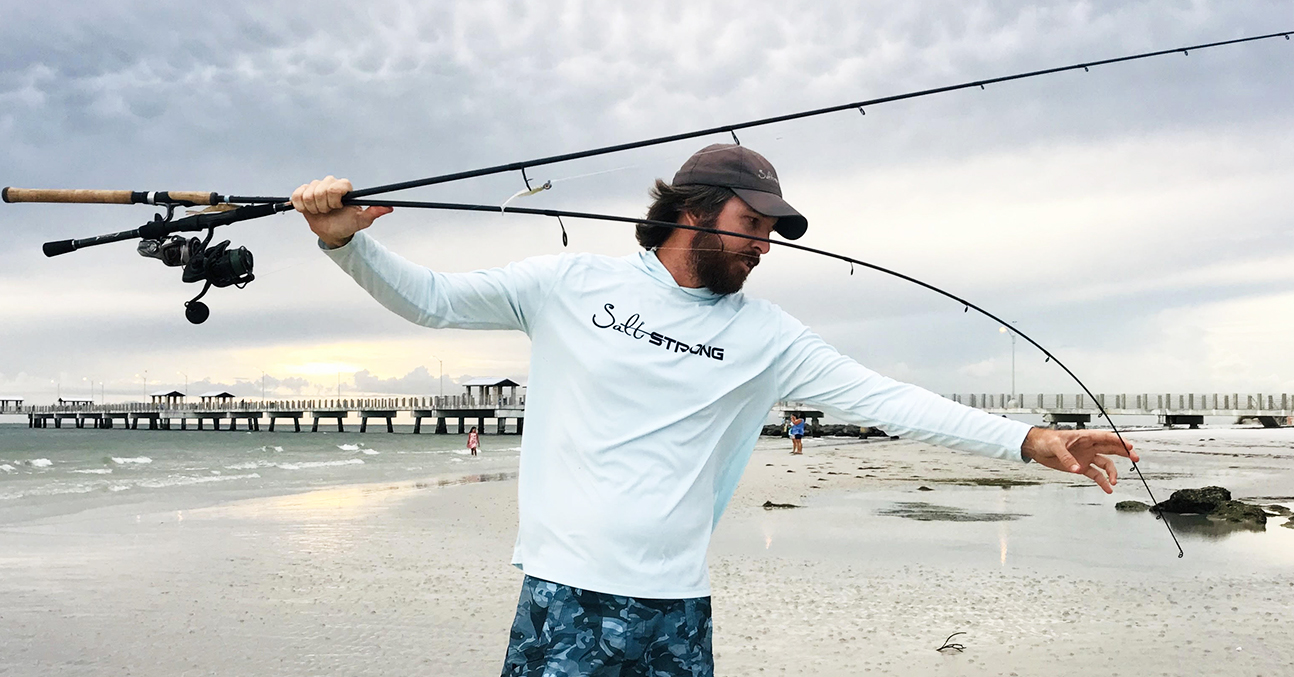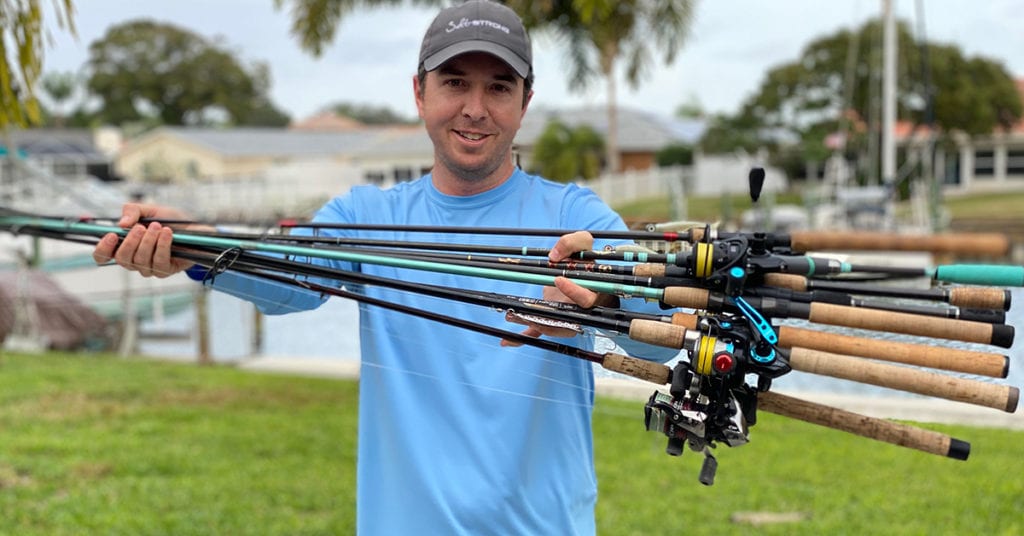Fishing Rod Power vs. Action (How To Choose The Right Rod For You)
- By: Luke Simonds
- on

Picking out a fishing rod can be confusing with the different power ratings and action…
What do those terms even mean?
And to make it more confusing, there’s no real standard to power and action, so one medium power rod might be equivalent to a heavy power rod in another brand.
So how can you pick the right rod for you?
In this video, you’ll learn what the definitions of power and action are when it comes to fishing rods, what you want to look for in a rod, and how to do the “feel test” to see how a rod stacks up against others.
Check it out below.
Power vs. Action Explained [VIDEO]

Power is the measure of how much force it takes to bend the rod.
When you’re fishing with artificial lures, you’ll want a rod that’s on the stiffer side so that you can get a good hook set and have enough power to bring in the fish.
Usually, you’ll want a medium-heavy rod, but it could be medium or heavy, depending on the brand.
For instance, one of my favorite rods is the Temple Fork Outfitters Professional Series.
I like to get the medium power model.
On the other hand, the G Loomis E6X heavy power rod feels just like the Temple Fork Outfitters Professional Series medium power rod.
Now, let’s talk about action.
Action is where in the rod does the bend happen.
A fast action rod means that only the top part of the rod will bend, whereas a slow or moderate action rod might start bending more towards the middle part of the rod.
A fly fishing rod is the ultimate slow action rod example because the whole rod flexes to propel the line forward.
Now when it comes to inshore fishing with artificial lures, fast action is better because it can help you cast farther, you’ll feel the bite better, and you’ll get better hook sets.
And just like power, there’s no real standard for action ratings among different brands.
But as an example, the only part of my Temple Fork Outfitters Professional Series fast action rod that bends is just the top 25%, so you’ll want to look for a rod that has similar action.
How To Choose The Right Rod For You
To choose the best rod for you, here are two options:
Option 1: Do the feel test
If you’re in a store, put the rod tip down on the floor and bend it.
You’ll be able to feel how much pressure it takes to bend the rod compared to others (to get a good idea of the power of the rod), and you’ll be able to see where in the rod it starts to bend (to get a good idea of the action of the rod).
Option 2: Check out our recommendations
Since this can be a confusing (and expensive) decision, we’ve reviewed a ton of rods to show you which brands and models we like, and which ratings we like for them.
We don’t accept sponsorships from any of these companies (we’re fully supported by our Insider Club) so we’re free to give you unbiased reviews so that you can get the best equipment for your money.
See all of our rod reviews here.
And a final note on picking the right rod: don’t put too much stock in the rating, but do make sure that the line you’ll be using fits within the recommendations for the rod.
For example, my Temple Fork Outfitters rod is rated for 6-12 lb. line, and I usually use 10 lb. line with it.
Conclusion

When it comes to fishing rods, power means how much force it takes to bend the rod, and action means where in the rod it starts to bend.
You’ll typically want a medium-heavy rod with a fast action tip, but these ratings vary from brand to brand (and even within different models of a brand), so do the feel test or check out our rod reviews to help decide which rod is best for you.
Have any questions about choosing a fishing rod?
Let us know in the comments below!
And if you know someone who’s looking for a new rod, please TAG or SHARE this with them!
P.S. Want access to our best fishing spots and tips, plus discounts to our online tackle store? Click here to join us in the Insider Club!
Related articles:
Related categories:
STOP WASTING TIME ON THE WATER!
Do what the “SMART ANGLERS” are doing and join the Insider Club.
Here’s what you’ll receive today when you join:
- Weekly fishing reports and TRENDS revealing exactly where you should fish every trip
- Weekly “spot dissection” videos that walk you through all the best spots in your area
- Exclusive fishing tips from the PROS you can’t find anywhere else
- Everything you need to start catching fish more consistently (regardless if you fish out of a boat, kayak, or land).










I realize the rods are marked from the manuf. what size line to use, you said you like to get somewhere in the middle. Let’s say a rod has a 10-17 lbs for line size. What happens when you put lets say a 20lb test line on that rod?
A lot of good information especially for those who fish ARTIFICIAL bait. I do not use them.Who is the resident expert on real bait on your team that is?
Capt. Peter Deeks is our natural bait expert for inshore fishing. He has some awesome courses that can be found on the Courses page in case you haven’t seen them yet: https://www.saltstrong.com/courses/
GETTING TO KNOW YOUR FISHING ROD GUIDES.
Something that is seldom talked about that Salt Strong members find useful.
1)Insert Ring/Loop Sizing
The first measurement in a Tip-Top is the OD of the ring (eyelet) in millimeters. Generally, the inside diameter (ID) of the ring will match the smallest guide on the rod. Standard sizes are 6, 8, and 10mm for conventional rods, while heavier saltwater rods may go as high as a 16mm ring.
2)https://blog.mudhole.com/getting-know-fishing-rod-guides/#.X0mUTshKjIV
3)Cone of Flight
The cone of flight layout has long been used for spinning rods and uses increasingly smaller rod guides to gradually narrow the “cone of flight” as the line nears the tip. This system generally uses fewer total guides than other layouts, but the problem with this system is that large, heavy guides usually are used. Many builders, when they test-cast rods, find that the cone of flight system doesn’t improve casting distance when compared to the “new guide concept” layout.
4)The “concept” layout, popularized by guide manufacturer Fuji, uses significantly smaller guides than the cone of flight layout, but also requires more rod guides. This system is thought to increase casting distance with braided lines on spinning reels. Because braided lines come off the spool with less memory than monofilament, there is no need for a “cone of flight” layout to gradually restrict the line until it leaves the tip.
5)Other benefits of the concept layout include a lighter, more sensitive rod and a smaller “footprint” on the rod blank, which allows the rod the bend more naturally. The downside is that there are more small guides that could potentially be damaged or broken. Also, the small guides don’t pass knots or splices through them quite as well, and they ice up more easily in freezing-cold weather.
6)For baitcasting and conventional rods, spiral wraps, also known as “acid wraps,” have become increasingly popular. The idea of a spiral wrap is to move the line from the top of the rod to the bottom of the rod, reducing the torque on the rod. This keeps the rod from wanting to turn over when you are fighting a fish.
7)Single Foot vs. Double Foot
Many rodbuilders like single-foot guides because they have less of an impact on the rod’s action, and wrapping them on the rod requires half the work of double-foot guides. For rods intended for heavy-duty use with large species, double-foot guides are a better choice as they will stay securely anchored and resist twisting, even under heavy loads
8)K-Frame
Touted as “tangle free,” these guides are useful on spinning and surf rods that will be used with braided line. Anglers who do frequent casting and retrieving will appreciate the reduced frequency of tangles.
Micro guide
Micro Guides
Guides with a ring size of 7 or smaller are considered micro guides. Popular with freshwater bass fishermen, these guides are extremely light and add minimal weight to the rod. Rods built with micro guides often require 10 or more guides to achieve the proper action.
roller guide
Roller Guides
Anglers trolling or bait fishing for big gamefish turn to roller guides to minimize the friction between the line and guides when large tuna or billfish take screaming runs against tight drag settings.
https://www.onthewater.com/what-you-need-to-know-about-rod-guides
Thanks so much for sharing the helpful details!
Hey Luke. Off topic, I’m trying to understand the life cycle of the Greenback bait fish used around here. Earlier in the year you could pretty much find them anywhere ranging from any size. Larger were schooling hard off the beaches and nice bait size were more around structure like markers or piers. Now in August all my usual spots are full of fry. Anglers I’ve talked to say to chum the flats but those things are super small. Where do the larger baits go after spawn? I got lucky and ran up on some schooling down current under a light by the bridge bumpers at John’s Pass, but to consistently find them…the struggle is real. I know, I know, all you need is a good lure, but live bait fishing is awesome. There’s nothing like when that bait fish starts to run for its life and you know it’s about to go down. The water here is so clear so a lot of times you get to see it happen. Not to mention if you have the gear to catch them and keep them alive, they’re free. I was fishing the flats out by the Skyway bridge and I must have gone through 3 packs of ZMAN soft plastics. Grouper destroy those things. A shark or puffer will hit it and it’ll come back chomped in half or with no tail. It gets expensive. People on Amazon are selling 1 pack of Diezel Minnowz for like $10 right now. That’s double for what they normally sell for. Angler to angler, I need some insight. I’ve been furloughed from work for the next couple of weeks so this is my chance to step my game up. If you get a moment please share a little knowledge with me. Stay safe. Deuces.
I have used live whitebait about 10 times in the past 5 years, so I’m definitely not an expert on them.
From the live bait fishing I used to do in my earlier years, it seems like the biggest ones are typically holding out in deeper water (10+ ft) in areas with good current flow and structure in and around the passes and inlets. Dropping sabikis behind channel markers that line the main channels will often help identify where they are holding. Once some are located, I’d then anchor down up-current and chum them up to the boat so I could net them. Many of the guides get out on the water before the sun comes up and throw nets behind their favorite markers to catch a day’s worth of bait since it’s much easier to get them in bulk before dark than it is while the sun it up.
What do you think abou a long surf rod? Wouldnt a slow action cast further in the surf?
I have not done any tests with long surf rods, so I can’t say for sure. But I believe that a faster action rod would still cast farther than a slower action rod all else considered equal because the faster action blank should technically snap the lure forward a bit quicker while also having less post-cast flexing which will decrease the drag on the line as it’s shooting through the guides.
Luke, thank you for the video. I changed my pop and cork rod from a medium to fast heavy and in my opinion my hook sets has increased. So now i have a medium rod and I’m thinking i should rig it up with my top water snook jr lure to help with motion and so I don’t set the hook (which it typically instinct) when I see the splash verse when I feel the fish on the lure. Thoughts?
It’s worth a shot… I personally like my main MH fast action rods for topwater too.
The only time I find that I prefer the more flimsy rods is when I’m live bait fishing with small baits because the longer rod bend helps prevent me from casting the baits off the hook.
are line rating on rods for strength or diameter?
Strength. On some 3000 reels I’ll use 20lb braid because it’s only the diameter of 6lb mono. It casts a lot better BUT it can break a rod rated for 6/15lb test. I know this and know that if I have big fish and I want to gold the drag to put pressure on th e fish…I CANNOT pull on the rod like you normally do using all the action of the rod. I know I have to point my rod down more towards the fish and NOT tear back on the rod. It would break. When your rod is pointed to the fish it could b 100lb test because you’re not pulling up on the rod bending it until it breaks.
That’s why you see a lot of broken rods everywhere you go. Heavy braid on a lighter rod and the person didnt compensate for it in the way they “bend the rod”.
I disagree with your conclusions that a fast action rod will cast farther than a mod action rod. There is so much more that goes into it to generalize like that. Also, are you familiar with the CCS rod measurement system which yields real, objective, numbers that allow accurate comparisons between rods. For both power and action. .This would allow you to measure a favorite rod, then find a similar rod with your feel test. BUT, you could take the rod home and measure it, and if the numbers are close, it’s about the same rod (there still is the recovery speed to be considered-that can be measured too, but it’s not as easy. But the lighter of two rods of similar CCS numbers will most likely recover faster). If the numbers are not close enough, take it back. You have not hurt it or done anything that would prevent it from going back on the shelf. CCS is applicable for ALL rods, fly, spin, cast, and even very powerful salt rods. When you have a “library” of rod data you’ll find you can match rods quite easily. Works on blanks just as well as rods.
https://www.common-cents.info/
I totally agree that there are a lot of variables that will impact casting distance. My statement about faster action rods casting farther was assuming that all else is equal… the quicker snap back into shape should provide more lure speed.
Hey Luke, nice video. I’m looking for a baitcasting rod for inshore fishing. My last rod snapped when I set the hook… Fo you have any recommendations?
Thanks Martin! I haven’t used baitcasting setups much at all over the past 10 years, so I would not be doing you justice by recommending any baitcasting rods.
Very informative. You did not mention lure weight rating You usually use 1/8 weighted hooks but the rod you showed has a minimum rating of 1/4. Do you take this into consideration when purchasing a rod. Thanks for all you do.
Yes. But we also must factor in the total weight of the lure… for example, a 3 inch paddletail rigged on a hook with a 1/16th oz weight will still weight .3 lbs when weighed together. And the 1/8th oz jig head will weigh even more.